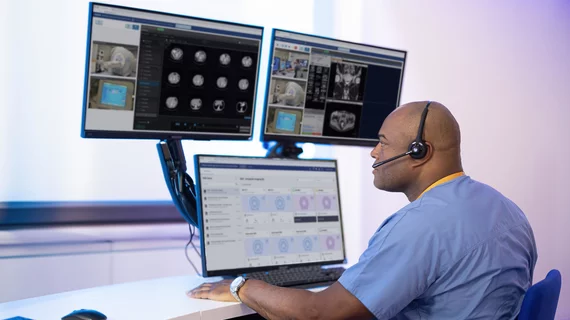Imaging leaders share 7 key considerations for remote scanning programs
The implementation of fully remote scanning capabilities within imaging operations is on the horizon, with some facilities already successfully deploying remote technologists.
Many believe remote scanning can address the shortage of skilled technologists, but it is accompanied by a slew of unaddressed concerns. A new report released by the Association for Medical Imaging Management (AHRA) provides an in-depth overview of the concerns related to deploying fully remote operations, highlighting everything from safety issues to regulatory oversight and technologist and facility accreditation.
The insights provided are specific to remote MRI scanning. The key areas of consideration are as follows:
Safety: Recent adverse MRI events have resulted in serious injuries and even death—and those were in the physical presence of skilled staff. Taking this into account, it’s understandable that many would express serious concern for how exams conducted remotely could put patient safety at risk. Although these exams should be completed with at least one technologist physically present, if a safety issue were to occur, the remote technologist has limited capacity to intervene. Compounding these concerns is the fact that there are very few concrete MRI safety regulations, despite decades' worth of evidence and protocols to build from. This begs to question how something as new as fully remote operations would fare in terms of ensuring patients and staff are protected. AHRA notes that there must be policies in place to fill the additional gaps in care that would arise in such scenarios, but the association did not provide specific guidance on what these policies should look like.
Technologist certification and facility accreditation: AHRA states that any facility considering implementing fully remote operations should ensure that technologists are compliant with all applicable accrediting bodies approved by CMS for advance diagnostic imaging (i.e., the American College of Radiology, Intersocietal Accreditation Commission , RadSite, and The Joint Commission) as well as those put forth by their state. Remote techs should be fully certified, registered and licensed in the state where they are performing exams. This also applies to scans that are conducted remotely across state lines.
The FDA’s role: The Food and Drug Administration's Center for Devices and Radiological Health is responsible for regulating imaging equipment and software. AHRA describes the center's assessments of these products prior to approval as playing a “critical” role in creating a safe and effective remote scanning environment. The association notes that any facilities implementing fully remote operations needs to ensure that the equipment and/or software they are utilizing has been tested and approved by the FDA for their intended use.
IT support: This is a critical aspect of any remote scanning program. Facilities need to consider the type of remote support they will require, taking into account things such as MRI machine manufacturers and whether they will need multiple IT vendors to accommodate different types of machines. Cameras are another consideration. Though not required, they offer remote techs a fuller picture of the exam. Facilities need to determine if they will utilize cameras and, if so, how many they will need and where they will place them—behind the control panel, near the contrast injector, in various safety zones, etc. The remote tech’s setup also should be thoughtfully considered.
Risk management: Who is responsible for what during exams—the on-site or remote tech? The most minute details of every exam need to be considered to delineate responsibility. Staff should be well trained and educated on the duties of all parties involved.
Education and training: All on-site and remote techs, plus all designated MR Level 2 personnel, should be thoroughly educated on remote scanning policies, procedures, and related equipment and software programs. This should include training on what to do when network connections are lost, monitoring activity in the MRI suite (including around contrast injectors) communicating with on- and off-site staff and other workflow related protocols.
Regulatory considerations for independent diagnostic testing facilities (IDTFs): Technologists must ensure they are in compliance with special regulations applicable to IDTFs, including those related to nonphysician personnel. Techs can be considered either employees of the IDTF or independent contractors. Which role they are given depends on the individual IDTF’s credentialing requirements. This also will affect liability insurance coverage, AHRA notes.
The overview was the result of collaborative efforts between AHRA, ACR, the American Society of Radiologic Technologists, American Registry of Radiologic Technologists, IAC, RadSite, the Radiology Business Management Association and TJC. A detailed summary of fully remote operations considerations can be found here.

